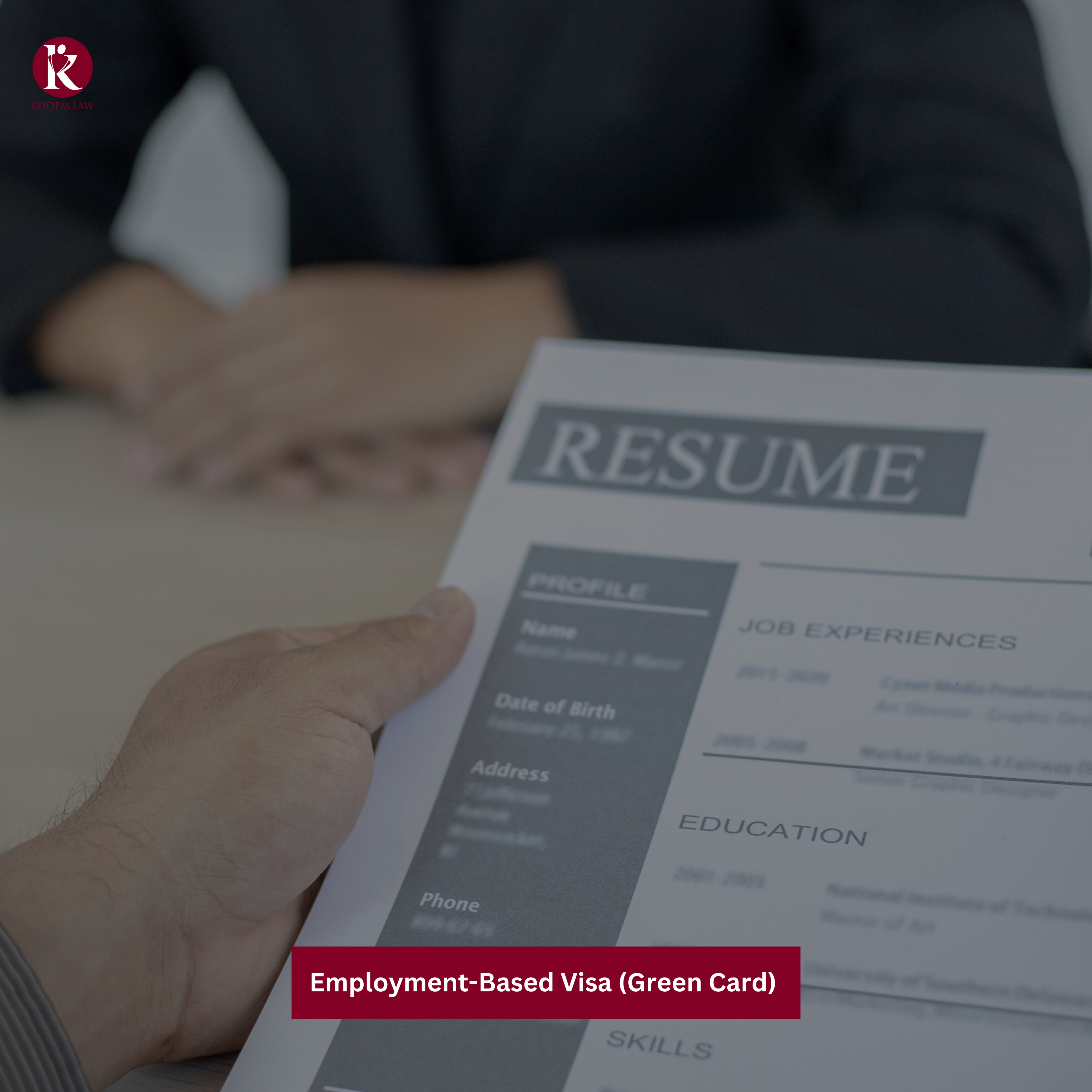
The USCIS Employment-Based Green Card is for foreign nationals in the U.S. to obtain permanent residency through employment. The application process is rigorous, with various categories available for individuals to apply. The availability of these visas is influenced by the monthly published Employment-Based Visa Bulletin from the U.S. Department of State.
Green Card for employment-based immigrants provides permanent residency to foreign nationals sponsored by their employers. The application process, overseen by the USCIS, includes steps such as employer sponsorship, petition approval, and the submission of a permanent residency application.
Seeking an Employment-Based Green Card? Explore this comprehensive guide for insights on categories, and requirements, and get expert assistance.
Steps for Filing Employment Based Green Card Visa
Step 1 – Determine Eligibility: Research and identify the suitable employment-based visa category that aligns with your situation. Ensure you meet the criteria for that specific category.
Step 2 – PERM Filing (ETA 9089): Your employer files the PERM application (ETA 9089) with the U.S. Department of Labor (DOL). This is for permanent employment certification and takes about 8.5 months.
Step 3 – Form I-140 Petition: Your employer submits Form I-140, Immigrant Petition for Alien Worker, to USCIS. This establishes your eligibility in the chosen employment-based category.
Step 4 – Priority Date Waiting: Await the priority date to become current according to the Visa Bulletin. This date is based on when USCIS receives your I-140 petition.
Step 5: Adjustment of Status: If in the U.S., file Form I-485 to adjust your status to permanent resident after your priority date becomes current.
Additional steps to be followed if the employee is (Outside the U.S.): If outside the U.S., file Form DS-260 for Immigrant Visas via the Consular Electronic Application Center (CEAC).
- Attend Visa Interview: Attend a visa interview at a U.S. embassy or consulate in your home country if applying from abroad.
- Biometrics Appointment (Consular Processing): If applying through consular processing, attend a biometrics appointment.
- Green Card Interview and Decision: Depending on your situation, a USCIS interview may be necessary. After completing all steps, including any interviews, you’ll receive a decision. Approval leads to your Employment-Based Green Card.
Note: Remember, the specific requirements and procedures can vary depending on the visa category and country. It’s important to seek professional advice to ensure you have accurate and up-to-date information for your specific circumstances.

Employment-Based Visa Categories in the United States
| Employment-Based Visa Category | Description |
| EB-1 | For individuals with extraordinary abilities, outstanding professors/researchers, or multinational executives/managers |
| EB-2 | For professionals with advanced degrees or exceptional ability in sciences, arts, or business |
| EB-3 | For skilled workers, professionals, and other workers with at least two years of experience |
| EB-4 | For special immigrants, including religious workers, broadcasters, Iraqi and Afghan translators, and certain other groups |
| EB-5 | For immigrant investors who invest a minimum of $900,000 in a new commercial enterprise creating jobs |
EB-1 Green Card: Multinational Executives/Managers
EB-1 Green Card for extraordinary ability requires evidence of:
- Recognized achievements: Receive respected awards/honors, such as Olympic Medals or Pulitzer Prizes
- Professional involvement: Belong to associations that demand outstanding performance
- Media recognition: Publication in trade journals or major media, showcasing your work
EB-2 Green Card: Advanced Degrees or Exceptional Ability
EB-2 Green Card (Exceptional Ability) Requirements:
1. Exceptional Skills: Demonstrate outstanding abilities in science, art, or business, exceeding average proficiency
2. Evidence Criteria: Submit proof of meeting at least three of the following:
- Relevant degree, diploma, or similar award
- Minimum 10 years of full-time professional experience
- Professional license or certification
- Salary/compensation reflecting exceptional ability
- Membership in professional organisations
- Recognition by peers, government agencies, or professional/business organisations
3. Comparable Evidence: Acceptance of other eligible forms of evidence
Note: Additional requirements may be specified in the Labor Certification process
EB-3 Green Card: Skilled Workers, Professionals, and Other Workers
EB-3 Green Card (Professionals) Requirements:
- Education Qualification: Possess a US or foreign equivalent college degree that is necessary for your occupation
- Job Offer: Secure a permanent full-time job offer
- Occupation Requirement: The degree you hold must be a requirement for the occupation
EB-4 Green Card: Special Immigrants
The specific requirements for the EB-4 Green Card:
- Religious worker
- Panama Canal Company Employee, Canal Zone Government Employee, or U.S. Government in the Canal Zone Employee;
- Physician
- G-4 International Organization Employee o Family Member or NATO-6 employee or family member
- Afghanistan or Iraq national who worked with the U.S. armed forces or under Chief of Mission authority as a translator
- Iraq national who worked for or on behalf of the U.S. government in Iraq; or
- Afghanistan national who worked for or on behalf of the U.S. government or the International Security Assistance Force (ISAF) in Afghanistan
EB-5 Green Card: Immigrant Investors
The specific requirements for the EB-5 Green Card:
- No exceptional ability requirements for the EB-5 category
- EB-5 is focused on immigrant investors making substantial investments in new commercial enterprises in the U.S
- Minimum qualifying investment amount and job creation/preservation requirements apply
- Investment should be made in a designated Targeted Employment Area (TEA) or rural area for a reduced investment amount
How Long Is An Employment-Based Green Card Valid
- An employment-based Green Card in the United States is typically valid for 10 years
- The validity of a Green Card can vary based on factors such as the card category, issuance date, and expiration date indicated on the card itself.
- Permanent resident status does not expire, even if the physical Green Card does green Card holders may remain in the United States indefinitely, as long as they do not violate any of the terms of their residency
- Green Card holders may be eligible to apply for U.S. citizenship after a certain period of time, typically five years from the date of obtaining permanent residency
Can My Family Members also Receive Immigrant Visas?
Yes, family members of employment-based Green Card applicants may also be eligible to receive immigrant visas. Spouses and unmarried children under the age of 21 are generally eligible to apply for dependent visas and may be included in the primary applicant’s Green Card application. However, other family members, such as siblings or parents, may not be eligible for dependent visas and may need to pursue alternative visa options.
Numerical Limitations
Each year, the U.S. government places a cap on the number of employment-based Green Cards that can be issued, with a total of 140,000 visas available across all categories.
Within this overall cap, there are further limitations on the number of visas available in each employment-based category. The breakdown of visa numbers is as follows:
Employment-Based Visa Category | Annual Visa Limit |
EB-1 | Approximately 40,000 visas per year (28.6% of the annual limit) |
EB-2 | Approximately 40,000 visas per year (28.6% of the annual limit) |
EB-3 | Approximately 40,000 visas per year (28.6% of the annual limit) |
EB-4 | Approximately 10,000 visas per year (7.1% of the annual limit) |
EB-5 | Approximately 10,000 visas per year (7.1% of the annual limit) |
- These percentages represent the allocation of visas for each category out of the total annual limit. It’s important to note that the exact number of available visas may vary each year depending on various factors and government regulations.
- The number of visas available in each category is further limited by country of origin, with no more than 7% of the total visas available in any given category going to applicants from any one country.
- Due to the limited number of visas available, there is often a backlog of applicants waiting for their Green Card applications to be processed, particularly in certain categories. This can result in long wait times and delays for some applicants, with wait times ranging from several months to several years.
- It’s important to note that the numerical limitations and wait times can vary from year to year, based on factors such as changes in immigration policy or shifts in demand for different categories of Green Cards.
Required Documentation
Sure, here are some of the required documents for an employment-based Green Card application:
This document, obtained through the U.S. Department of Labor, demonstrates that the employer has tested the job market and found no qualified U.S. workers available for the position
The Immigrant Petition for Alien Worker is filed by the employer to establish that the applicant meets the criteria for the job and that the employer is willing and able to offer the required wages
The Application to Register Permanent Residence or Adjust Status is filed by the applicant to request a Green Card and undergo the process of adjusting their immigration status
A valid passport is necessary to establish the applicant’s identity and nationality
The applicant’s birth certificate serves as proof of their date of birth
If the applicant is married and seeking to include their spouse in the Green Card application, a marriage certificate is required
A police clearance certificate from the applicant’s home country or countries of residence may be needed to demonstrate good moral character
The applicant must undergo a medical examination by a designated physician to ensure they meet the health requirements for immigration
The applicant may need to provide financial records, such as tax returns or bank statements, to demonstrate their financial stability
Additional supporting documents, such as educational certificates, letters of recommendation, and employment verification letters, may be required to strengthen the application
Note: It’s important to note that the required documentation can vary based on the specific employment-based Green Card category and the circumstances of the applicant’s case. Consulting with an immigration attorney or reviewing the USCIS website can provide more precise and up-to-date information on the required documentation for a specific category.
How long does it take to process?
- Processing time for Employment-Based Visa (Green Card) applications can vary.
- Factors such as visa category, country of origin, and government efficiency can impact processing times.
- Processing times can range from several months to several years.
- Steps involved in the process include labor certification, Form I-140 petition approval, and Form I-485 application for the Green Card.
- PERM process can take months to years, I-140 approval varies, and I-485 application processing can take several months.
- Checking the USCIS website or consulting an immigration attorney for up-to-date information is recommended.
How Can Kodem Law Help You?
Kodem Law specialises in employment-based Green Card applications, offering comprehensive support throughout the process. They ensure accurate organisation and review of documentation, provide guidance on addressing concerns, and have expertise in immigration law to help you understand interview requirements. With Kodem Law, you can be well-prepared and confident for your employment-based Green Card application.

